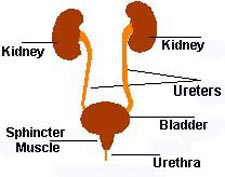Resources | Education
Information in this section is courtesy of http://www.tena.us/ website)
ANATOMY OF INCONTINENCE
Urinary incontinence is a problem of the urinary system, which consists of two kidneys each connected to a bladder via a tube called a ureter. A single tube, the urethra, connects the bladder to the outside of the body.
Kidneys remove waste products from the blood and produce urine. The ureters move urine from the kidneys to store it in the bladder until it flows out of the body through the urethra. A circular muscle called the sphincter controls the activity of the urethra.
In normal circumstances, the bladder stores urine until it is convenient to urinate, but incontinence can result when part of the urinary system malfunctions.
WHAT IS INCONTINENCE
Incontinence means the involuntary loss of bladder or bowel control and is a symptom, not a condition in itself. There are a wide variety of conditions and disorders that can bring about incontinence, including birth defects, the effects of surgery, nerve damage, infection, and changes associated with aging. It can also occur as a result of pregnancy or childbirth.
Incontinence exists among children, men and women of all ages. At some stage during their lives, 1 out of 4 women and 1 out of 8 men will be affected.
The scale of the condition varies too –in the case of urinary incontinence, from small and infrequent dribbles, to the occasional loss of bladder control or a total inability to hold urine.
INCONTINENCE AND AGING
Aging causes a number of changes in the urinary system that can cause incontinence:
– Less bladder elasticity – lowers capacity and causes more frequent voids
– Higher urine volume – kidneys less efficient at concentrating urine
– Weaker detrusor muscle causing incomplete emptying
– Increase in spontaneous contractions of detrusor muscle
– Less able to postpone urination
– Less urethral closing pressure
However, despite affecting a large number of older men and women, urinary incontinence should not be seen as a normal part of aging. It is a disruption of the physical and/or mental processes of storing urine and emptying the bladder at a convenient time, a disruption that can often be treated. Many older people are unduly affected by the inconvenience and embarrassment of incontinence. Professional care can help many patients and their families manage the condition successfully. Discreet and effective incontinence protection plays a key role in minimizing the effects and helping restore normal life.
The frail elderly are often in need of professional continence care – in their own homes or in a nursing home. Clearly the increasing effects of aging on the urinary system are the main reason for this; however there can be other issues, such as lack of mobility or dementia. Difficulty in reaching the bathroom or in communicating the need to urinate creates a need for continence care.
Achieving continence is particularly important because of the severely debilitating effect of incontinence on the frail elderly. There is an increased risk of skin conditions and bedsores, infections and sleep difficulties, not to mention the emotional distress and social problems that can arise.
The health and happiness of those in need of care can be safeguarded through good management of incontinence episodes. This can often be self-management by working with the patient to help them recognize the best way forward. Caregivers can also re-evaluate their choices of products and routines to ensure the effects of incontinence are minimized.
Click on the following Categories for more information on Adult Incontinence, Youth Incontinence, Toilet Training, and Patient Safety.
We hope that this information serves as a valuable resource.








